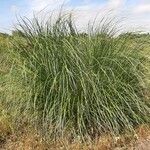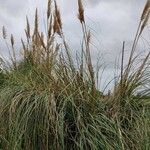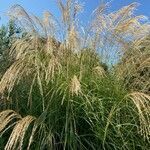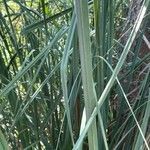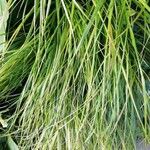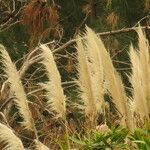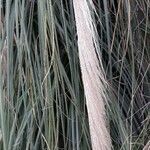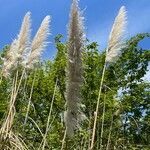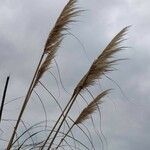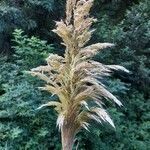Robust, densely tufted perennial, up to 4 m high; leaves mainly basal, up to 2/3 culm height. Leaf blade 800-1800 x 8-10 mm, apex setaceous, with margins and midrib cutting edges, usually markedly V-shaped in cross section, glaucous; ligule a fringe of hairs. Inflorescence a panicle, 400-600(-700) mm long, not or hardly extending above leaves, silvery-white to pink or mauve, branches stiff; spikelets either female or bisexual (but then functionally male. Spikelets 15-17 mm long, laterally compressed, disarticulating above glumes; glumes ± equal, as long as spikelet, glabrous, 1-nerved, nerves colourless; lemma entire, acuminate and awn-like or awned, 3-7-nerved, nerves colourless. Female spikelet on pedicel (0.4-)0.8(-1.0) mm long. Florets (5)6(7), densely hairy, hairs 7-12 mm long; palea 2.5-3.8 mm long, glabrous; anther minute, < 0.2 mm long. Bisexual spikelet on pedicel (0.8-)1.0(-1.3) mm long. Florets (1-)3(4); lemma glabrous or sparsely hairy; palea 3.5-5.5 mm long, glabrous; anther (1.5-)3.0-5.0 mm long. Flowering time Feb., Apr.
Robust, densely tufted perennial to 4000 mm high; leaves mainly basal, to 2/3 culm height. Leaf blade 800-1800 x 8-10 mm, apex setaceous, glaucous, blade with cutting margins and midrib, usually markedly V-shaped in cross section. Inflorescence 400-600(-700) mm long, not or hardly extending above leaves, silvery-white to pink or mauve, branches stiff; spikelets either female or hermaphrodite (but then functionally male), rachilla colourless; glumes ± equal, 8-15 mm long, 1-nerved, nerves colourless. Female spikelet pedicel (0.4-)0.8(-1.0) mm long; florets (5-)6(-7); lemma 10-14 mm long, 3-nerved, nerves colourless; densely hairy, hairs 7-12 mm long; palea 2.5-3.8 mm long, glabrous; anther minute, less than 0.2 mm long. Hermaphrodite spikelet pedicel (0.8-)1.0(-1.3) mm long; florets (1-2)3(-4); lemma 12-15 mm long, glabrous or sparsely hairy, 3-nerved, nerves colourless; palea 3.5-5.5 mm long, glabrous; anthers (1.5-)3.0-5.0 mm long.
Plants gynodioecious, or bisexual flowers functionally male. Culms 1–4 m high; internodes hollow. Leaves: sheath not waxy; blade 2 m long, 5–15 mm wide, erect, ±folded at base, with a distinct keel at least on lower leaves, without distinct secondary veins, dull green. Inflorescences shortly exserted beyond leaves, open, with 500–1000 spikelets, pink to purplish, drying grey. Male and bisexual spikelets and florets similar to female, but lemmas are glabrous or with a few hairs at the base. Female spikelets 10–17 mm long, with 4–8 florets. Female glumes substantially exceeding florets, similar or usually unequal in length, white, almost transparent; lower glume 9–14 mm long. Female florets: lemma 11–15 mm long, entire, awnless, with only central nerve reaching apex, villous, grey, with nerves same colour as lemma; palea linear to lorate, 4–5 mm long, glabrous between keels.
Perennial, densely tufted, up to 4 m high. Leaf blades 800-1800 mm long, 8-10 mm wide, leaves robust, mainly basal, glaucous, up to two-thirds culm height; blades with cutting margins and midrib, usually markedly V-shaped in cross section, tips setaceous. Panicle 400-600(-700) mm long; spikelets either female or hermaphroditic (but then functionally male); female-fertile spikelets with (5-)6(-7) florets per spikelet, hermaphroditic spikelets with (l-)3(-4) florets; glumes of equal length, 8-15 mm long; glume veins, rhachises and rhachilla colourless; lemmas of female-fertile florets 10-14 mm long, those of hermaphroditic florets 12-15 mm long.
Perennial forming large tussocks. Culms robust, 2–3 m tall. Leaf blades stiff, 50–200 cm, 4–10 mm wide, glaucous, margins sharply serrulate, apex acuminate; ligule 2–4 mm. Panicle 30–100 cm, silvery or sometimes pinkish; branches erecto-patent in bisexual, patent in female plants. Spikelets dimorphic, florets 2–5; glumes linear or lanceolate, acuminate; lemmas 3-veined, gradually tapering to an entire apex continuing into a slender awn. Female spikelets: glumes 8–9 mm; lemmas 8–14 mm, densely silky villous; palea 2.5–3 mm; minute staminodes present. Male spikelets:glumes 9–18 mm; lemmas 11–17 mm, sparsely pilose; palea 4–6 mm.
Robust perennial to 3 m, in large tussocks. Leaves linear, keeled, serrulate. Spikelets in dense feathery panicles to 60 cm long, awned.
A tall grass. It grows 2-3 m tall.
